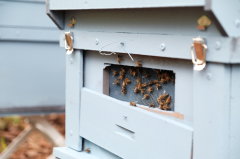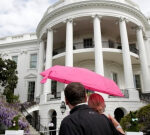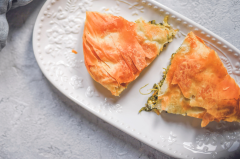Bees are vital to the ecology of our planet and also to our human food supply. The busy insects pollinate over 80 per cent of the world’s flowering plants, according to a 2022 report into native bees by AgriFutures Australia. While the European honeybee (Apis mellifera) gets most of the limelight and credit, there are over 20,000 other bee species across the globe. Research suggests the contribution of wild bees to pollination is even greater than the Apis species.
With bees of all kinds increasingly threatened — by pesticides and other agrichemicals, climate change, habitat loss and varroa mite (a parasite decimating honeybee populations) — native bees have been thrust into the spotlight. Seemingly unaffected by varroa, and viewed as a saving grace for the planet, the native pollinators have become the subject of growing fascination.
Meliponiculture
While there are approximately 1700 native bee species across Australia, only 11 of these live in communal hives within a rigid, complex social structure like the European honeybee, which allows them to be moved about and managed by humans. Known collectively as Meliponini or “social stingless native bees”, they consist of two genera: Tetragonula and Austroplebeia. Across the world, however, there are over 500 different species.
Meliponiculture is the practice of stingless native beekeeping. A 2021 survey found at least 1158 native stingless beekeepers (and 11,971 nests or hives) within Australia. One such enthusiast is Greg Coonan, author of Keeping Australian Native Stingless Bees. Coonan, who offers support and advice to others keeping the bees, reveals they’re mostly kept for enjoyment and to help the environment. Along with pollinating edible and ornamental gardens, they’re important pollinators of native plants.
Coonan’s menagerie, in suburban Brighton, Brisbane, consists of 20 hives and three Meliponini species native to southeastern Queensland: Tetragonula carbonaria, T. hockingsi and Austroplebeia. Most are rescued bees still in their original home. A mature native hive has a population of about 8000 to 10,000 bees, he says. Rather than beeswax combs, the Meliponini store their honey in little pots.
Relatively unaggressive and stingless, they’re great around children and pets. Another key difference is their smaller size. “They look like a house fly,” he says.
Climate factors
Unfortunately, keeping the Meliponini is limited by where you live. While solitary and semi-social bees are found in all regions of Australia, the social stingless variety are only found in warm parts of the country, including Queensland, the Northern Territory, northern half of Western Australia and northern coastal parts of NSW. Native to tropical and subtropical regions, “they haven’t evolved to go down into the temperate climates,” Coonan explains. Only T. carbonaria is suitable for warmer parts of NSW: and the Northern Rivers region down to as far south as Bermagui, he says.
The colder than average recent winter killed off several of Coonan’s small rescued hives. Below 18°C, the stingless social bees are unable to fly and stay in the hive, he says. “They don’t really get active until about 21 degrees.” When it gets really cold, the bees don’t sleep either, but work to protect the eggs. “They’ll build a crafted inner chamber in and around their brood with a material called involucrum,” Coonan says. “All the bees pack in around their brood to vibrate their bodies to generate heat to keep their brood warm.”
Hive behaviour
Like the European honeybee, the colony revolves around the queen and her brood. However, unlike the honeybee queen, the native social bee queen can no longer fly once she begins mating and laying eggs. “The bees aren’t going to leave her,” Coonan says. “They can live in a good box or a natural home, like a log, literally for decades.”
Unlike her honeybee equivalent, the native social queen has a single mate. “She’ll carry that sperm in a sac in her body all her life [which is roughly two years],” Coonan says.
Eighty per cent of the colony are “hive bees” with roles in the nursery with the queen, and working in food and beverage in the honey and forage stores, Coonan says. The other 20 per cent are “gatherers” collecting pollen (the bees’ protein source), nectar and tree resins for building honey pots and sealing their chambers. Gatherers only live about two to three weeks if they’re lucky, Coonan says. “Just about everything wants to eat the little guys: other predator insects, little birds, geckos, lizards and particularly spiders. It’s just the natural attrition rate; they must be a really valuable food source because there’s something eating them all the time.” To keep the population thriving, the queen lays 350 to 400 eggs every day of her life, Coonan says.
Re-queening the hive
The hives are very efficient at re-queening when needed. “They’ll often keep a couple of princesses in the hive so it has a contingency,” Coonan says. The egg cells also contain many larger outer cells for replacement queens, he says.
When a hive needs to re-queen, thousands of drones (male bees) will suddenly appear from up to five kilometres away, he says. “Because they’re from other hives, they’re not allowed into the hive.” Roosting on nearby branches at night, clustered together for protection and swarming around the hive all day long, they’ll remain there until they die.
Sourcing a hive
The Aussie Bee website lists most of the hive suppliers in Australia, Coonan says. Try to buy from someone local to you. “The bees are more likely to be acclimatised to the environment you’re in; you’re more likely to get ongoing support systems and people to mentor you,” he says.
Gaining a hive means relocating one that’s already established. “People put out empty boxes and other objects hoping they’ll be colonised, but there’s not much chance of it happening,” he says. “They’re not like honeybees. They’re extremely uncooperative, stubborn and only do what they want to do. Give them the home they’ve chosen themselves.”
Coonan’s rescued colonies reside in logs (brought to him by tree loppers and firewood cutters), a mailbox stand, water bottle, porcelain fish and water meter pit. “They occupy so many different places. It’s amazing,” he says. In the wild, the social stingless natives typically favour the hollows of old dead trees created by termites.
Within the industry, a hardwood timber box known as the OATH (Original Australian Trigona Hive) is commonly used, Coonan says. What’s key is that their chamber is secure from the elements, other insects and predators, he says. The native bees also use sticky tree resins to line and seal their chamber, be it a box or natural home. “When the





